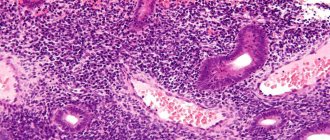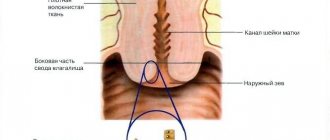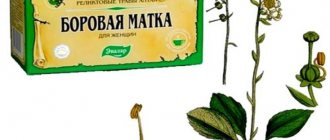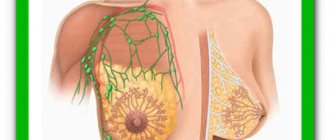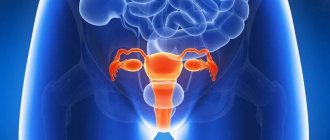There are a number of diseases that develop only in females, due to the peculiarities of their anatomical structure. One of the most common such pathologies is a cervical cyst. Most often, this disease is completely asymptomatic and is detected only during an annual preventive examination by a female doctor.
Before treatment, you should consult your doctor.
When is treatment with folk remedies justified?
Alternative medicine methods can be used in the following situations:
- Endometrioid cyst of the cervix without severe clinical symptoms;
- Retention (nabothian) cyst without active inflammatory process (cervicitis);
- The size of the cyst is up to 5 mm;
- The cyst does not create obstacles to conception and gestation or the woman is not planning a pregnancy;
- There is no concomitant cervical pathology requiring treatment.
In such conditions, there is no need for urgent drug therapy or surgery. A wait-and-see approach is allowed - observation by a gynecologist and regular examinations. If the disease does not progress, treatment is not prescribed. To improve the prognosis of the disease, you can help the body cope with the problem - and use folk remedies.
It is important to know
Before starting therapy, you need to visit a gynecologist, clarify the diagnosis and make sure there are no contraindications. In some cases, treatment at home can be not only ineffective, but also dangerous. While a woman douches with herbal decoctions and puts in tampons with honey, the disease progresses and the risk of complications increases.
Contraindications:
- Large and/or multiple cysts on the cervix with clear clinical symptoms;
- Concomitant diseases requiring treatment;
- Deformation of the cervix and narrowing of the cervical canal against the background of a cyst.
The photograph shows the beginning of cervical deformation against the background of nabothian cysts:
In these situations, the use of alternative medicine recipes does not make sense. The remedies offered by traditional healers are ineffective in the development of complications and rapid growth of tumors.
Home methods
How to treat tassels on the cervix with folk remedies?
Alternative medicine offers patients a huge number of treatment methods, but before treatment with traditional methods, it is imperative to consult with a specialist.
https://youtu.be/BhBt5As7TMU
Hydrotherapy
This method accelerates blood circulation in the right areas and thereby speeds up recovery.
- Fill two basins, one with hot water, the other with cold water, and sit down one by one: in the hot one for three minutes, in the cold one for one.
- Repeat the process three times, finishing with cold water, then wrap yourself in a warm blanket and warm up.
- Repeat this procedure every two to three days.
In case of pregnancy or menstruation, using this method is strictly prohibited!
Magic infusion
Grind 200 grams of Kirkazon fruits and pour in a liter of vodka. Let it brew for a week, then strain thoroughly and take daily diluted in a ratio of 50 milliliters of infusion per half liter (two glasses of water).
Garlic tampons
- Take a clove of garlic, carefully peel it from the film and pierce it 10-15 times with a sharp needle.
- Carefully wrap in disinfected new gauze, tie a thread to safely remove and insert into the vagina overnight.
- Remove in the morning and repeat the procedure daily.
The course of treatment lasts 10 days and is prohibited during menstruation, after a recent abortion or during pregnancy. It is believed that garlic will not cause pain in the vagina, but if you feel a burning sensation or any other discomfort, avoid these procedures.
Herbal medicine in the treatment of cervical cysts
Traditional medicine recipes based on the use of medicinal herbs are passed down from generation to generation. There is no evidence base here. No research has been carried out, and all that remains is to hope for many years of accumulated observational experience. For this reason, gynecologists do not advise getting carried away with herbal medicine and recommend using herbal decoctions and infusions only as an auxiliary measure.
Important aspects of herbal treatment:
- The effect of herbs on the human body has not been fully studied. The mechanism of their action cannot always be traced. Many medicinal herbs are believed to have anti-inflammatory, antimicrobial and antiseptic effects. Some herbal remedies have a beneficial effect on a woman’s hormonal levels. These properties are used to treat diseases of the reproductive organs;
- The effect of using herbal remedies occurs 2-4 weeks after the start of therapy. Herbal infusions have a cumulative effect. The minimum course of therapy is 2 weeks, but more often traditional healers recommend continuing up to a month;
- The effect of medicinal herbs on the body persists for 1-2 weeks after completion of the course of treatment;
- An allergic reaction to medicinal herbs is possible: skin itching, rashes, peeling. If such symptoms appear, you should stop taking the herbal medicine;
When treating with herbs, it is important to remember about a possible allergic reaction of the body.
- Some medicinal herbs are prohibited during pregnancy and lactation, against the background of pathologies of the digestive tract and kidneys. If you have any doubts, it would be a good idea to consult your doctor.
Herbal remedies for the treatment of cervical cysts:
- Garlic. Rich in phytoncides - substances that have a detrimental effect on pathogenic microorganisms. Peeled garlic cloves are wrapped in gauze, formed into a tampon and inserted into the vagina. It is assumed that the antiseptic properties of garlic help fight chronic cervicitis and the nabothian cysts that arise against it;
- Baked onion. It is recommended to eat one onion daily. It is unknown how onions affect the course of the disease. It is assumed that the complex of vitamins and minerals included in the beneficial plant strengthens the immune system and increases vitality;
- Chamomile. Has antiseptic and anti-inflammatory effects. Helps fight chronic cervicitis and nabothian cysts. Used internally and topically;
- Burdock. The juice of the plant is recommended to be taken orally. Burdock stimulates the immune system and directs all the body's resources to fight the disease;
- Ginger. Strengthens the immune system and speeds up recovery. Recommended for retention cysts and chronic inflammation of the cervix;
- Borovaya uterus. Traditional herb to combat gynecological diseases. Phytoestrogens in the boron uterus have a beneficial effect on hormonal levels. The herb also has a mild anti-inflammatory effect. Used for cervical endometriosis;
Borovaya uterus is considered a “female herb” because it contains analogues of female sex hormones.
- Red brush. Enhances the effect of boron uterus and has the same properties;
- Sea buckthorn oil. Activates local immunity. Accelerates tissue restoration. Prescribed after cauterization of the cyst during the rehabilitation period;
- Linseed oil. Powerful natural antioxidant. Activates blood flow in the pelvic organs. Normalizes hormonal levels;
- Celandine. It is a natural analgesic and antiseptic. Eliminates pain and inflammation in the vagina;
- Canadian goldenseal. Recommended for the treatment of endocervical cysts. Helps cope with inflammation due to blockage of nabothian glands. Used in the form of douching.
It is also useful to read: Effective methods of treating cervical cysts
Options for using plant materials:
- Decoction. The herbs are poured with boiling water and cooled. Can be taken 1-2 hours after preparation;
- Infusion. The medicine should be infused in a dark place for several days;
- Tincture. Prepared with alcohol, requires aging in a dark place. Not used during pregnancy and lactation;
- Solution for vaginal irrigation. Used for washing instead of hygiene products;
- Douching solution. Used for deep administration of herbal medicine. Not recommended by gynecologists. Douching washes away the beneficial microflora of the genital tract and creates conditions for the development of a secondary infection;
- Bath solution. Warm sitz baths are recommended for the treatment of gynecological diseases. You need to add a decoction of medicinal herbs to the water;
- Tampons. Inserted deep into the vagina. You can prepare tampons yourself or purchase them at a specialty store. Chinese tampons are popular for the treatment of gynecological diseases;
Chinese herbal tampons are popular among women. However, it is not uncommon to hear reviews from patients about allergic reactions and disturbances in the vaginal microflora.
- Ointments. Vishnevsky ointment based on birch tar and castor oil has an antiseptic and anti-inflammatory effect. Gynecologists do not recommend using this remedy. The use of the drug increases the risk of developing skin cancer and blood diseases.
It is difficult to cure cervical cysts with herbal remedies alone. According to reviews, herbal treatment does have an effect, but only for a while. After using herbal remedies, inflammation in the genital tract subsides and unpleasant symptoms go away, but the cyst itself remains. For small formations this is enough, because if the cyst does not bother you, it does not need to be treated. For large and/or numerous lesions, a different approach is required.
On a note
After completing a course of herbal therapy, you should undergo an examination by a gynecologist. If there is no effect, you need to change treatment tactics.
Symptoms
With cervical cysts, there are no symptoms as such, so pathology is revealed only during examination. There is an opinion that cysts are harmless and do not require intervention. However, they carry the risk of inflammation, which can cause suppuration. In some cases, they quickly increase in volume and deform the cervix. There is no drug treatment for such situations. Doctors advise removing them surgically, and immediately upon detection.
To treat or not to treat
How to treat cysts is chosen by the doctor, taking into account the characteristics of the patient. It is necessary to establish and, as quickly as possible, eliminate the cause of this disease. For this purpose, an impact is carried out on inflammatory processes, correction of identified hormonal disorders, including folk remedies. Sometimes, at an early stage of the disease, these measures are quite sufficient to successfully eliminate the pathology.
Causes of the disease and diagnosis
A simple gynecological examination with mandatory laboratory tests can identify the initial stage of the pathology and begin effective treatment in a timely manner. Cervical cyst is a common pathology, a consequence of inflammatory and hormonal changes in the female body.
To correct the diagnosis, a more thorough examination of the cervix using a colposcope is performed. The procedure is absolutely painless and does not require special preparation.
Treatment with folk remedies as an alternative
An important feature is that cervical cysts can resolve on their own. A correct lifestyle and a certain diet are the best helpers in treatment with traditional methods.
1. Nutrition structure.
You need to give up foods that provoke the growth of tumors. Eliminate all foods made by fermentation. It is necessary to provide the diet with nutrients rich in vitamins A, C and E and selenium, you can take complex vitamins.
2. Features of lifestyle.
Any actions that activate neoplasm processes are contraindicated. Thermal and other stimulating procedures should be avoided.
3. Self-love.
It is necessary to avoid stress and depression, treat or correct psychological problems, because cysts are their consequence.
In the treatment of cysts with folk remedies, the specific properties of plants are often used.
1. Decoctions and tinctures. Herbal mixtures and herbal extracts from them are used, obtained in various ways and having a general health-improving and anti-inflammatory effect. They are taken internally as a drink, externally - for irrigation, douching, tampons and baths.
How to treat cysts with infusion:
- Grind 1 spoon each of mantle grass, lemon balm, medicinal chamomile flowers and narrow-leaved peony, 1 liter of water, add boiling water to the mixture and leave for 10-15 minutes, strain. Take 1 glass of the drink in small sips 2-4 times a day, you can add honey.
- 1 spoon each of medicinal sage, rosemary, 1-2 tbsp. common oak bark, 2-3 liters of water. Pour boiling water, stand and strain. Douche daily. How to treat cysts with a decoction:
- 5 tbsp. thick-leaved bergenia root, 1 liter of water. Evaporate the water by half, dosage - 1 tbsp. before meals, every 3 hours.
- 1 spoon each of ginseng and zamanika roots, red root, Chinese lemongrass fruit, black currant leaves. bergenia, narrow-leaved fireweed herb, calendula flowers, 2 tablespoons of black bergenia leaves, 0.5 liters of water. In the evening, pour the mixture with water, bring to a boil in the morning, leave for 1 hour, strain. Take 1 glass 2-3 times a day. How to treat cysts with celandine:
- Place suppositories with celandine for 15 minutes in the morning and evening; the plant has the property of stimulating the replacement of pathologically altered epithelial cells with healthy ones. Course - up to 14 days.
- Infusion of celandine leaves: 0.2 liters of water, a spoonful of crushed leaves - steam with boiling water, strain, douche, then put a swab with honey. Course – up to 14 days.
2. Flax seed oil helps get rid of excess male hormones, take 2-3 tbsp. per day on its own or as a salad dressing.
3. Green tea extract in an amount of 400 mg per day has a noticeable general strengthening effect, as it contains 80% polyphenols.
4. Tampons with natural aloe juice. Freshly squeezed aloe vera juice is used. Moisten the swab with 1 tsp. juice, add and leave for 3 hours, lie down. Course - up to 7 procedures.
Prevention with folk remedies
Prevention involves, first of all, gynecological health. For the prevention of cervical cysts with folk remedies, multicomponent preparations can be proposed:
- mint and geranium herbs, thyme, elecampane root, licorice, birch leaves, meadowsweet flowers, chamomile;
- motherwort grass, shepherd's purse, chamomile flowers, rowan fruits, cuff leaves;
- flowers of tansy, chamomile, blueberry fruits, plantain leaf, celandine herb, yarrow, nettle, St. John's wort, tricolor violet.
Collections are used in the form of concentrated decoctions, infusions, 2 tbsp. The herbal mixture and boiling water are kept in a thermos and filtered before use. Used as a drink, 0.05 liters three times a day, as well as for gynecological baths in a dilution of 1:3.
Cervical cyst is considered a common gynecological disease, since it is diagnosed in almost a quarter of the examined patients who are of reproductive age. This pathology, according to doctors, is provoked by the presence of inflammatory processes in the genital area and erosion of the cervix. In most cases, it is detected only during a preventive gynecological examination, since it is predominantly asymptomatic. In some cases, due to the progression of inflammatory processes in the pelvic organs, suppuration of the cyst may occur, which is manifested by specific symptoms.
A reasonable question arises: how to treat a cervical cyst?
One can understand the women's concerns. But doctors reassure: when a pathology such as a cervical cyst is detected, treatment with folk remedies gives good results, so there is no need to resort to surgery. But only a qualified gynecologist should decide on the choice of treatment method.
Bee products against cervical cysts
Expected effects of using honey and propolis:
- Strengthening local immunity;
- Acceleration of tissue regeneration;
- Subsidence of the inflammatory process;
- Elimination of unpleasant symptoms.
Tampons for insertion into the vagina and suppositories for vaginal and rectal use are prepared from beekeeping products. The course of treatment is up to 14 days. Products based on honey and propolis are used as additional therapy, as well as after cauterization of the cervix. Efficacy has not been proven.
Bee products are strong allergens. It is possible to develop a reaction in the form of itching, burning, swelling of the mucous membranes, and skin rashes. If such symptoms appear, you should complete therapy and consult a doctor.
Bee products used in the treatment of inflammatory processes.
Herbal treatment
The use of decoctions of medicinal herbs, especially in preparations, gives excellent results due to their multidirectionality: providing an anti-inflammatory effect, a resolving effect on the cyst, and a stabilizing effect on hormonal levels.
Recipes:
- Yarrow, marigold, oak bark, sage grass. Take everything in equal proportions, 3-4 tbsp. Pour spoons of the mixture into a liter of water. Boil for 15 minutes, leave, take small sips throughout the day. The course is 14 days with a month break.
- Prepare the mixture in the following proportions: boron uterus, lemon balm, sage - one part each, oak bark, chamomile flowers - two parts each. Brew similarly to the first recipe and take 100 ml 3-4 times a day. Course – 14-25 days.
- Take nettle, plantain, marigold, chamomile, cinquefoil - one part each, sage, yarrow, oak bark - two parts each. Brew for 5-10 minutes, use for douching the night before bed.
- Upland uterus. 1 tbsp. Brew a spoonful of herbs in a glass of water, leave in a thermos for 3-4 hours. Take three times during the day. The course is 2-3 months.
- Golden mustache. Take 40 branches of mustache, pour vodka to cover the stems, leave for 14 days. Take 20 drops daily before meals, twice a day. Course – 7 days of admission, a week break. Take 4-5 courses.
- Tincture of green unripe walnuts. 4 tbsp. spoons of partitions pour 600 ml of water, boil for 15-20 minutes, leave. Take a quarter liter daily in 3 divided doses.
Other treatments for cervical cysts
Alternative medicine offers various other techniques. It is quite difficult to get rid of cervical cysts with their help. Most of the proposed remedies do not affect the cause of the disease, but only eliminate the symptoms. Temporary relief does not mean that the disease has gone away. The diagnosis can be confirmed or refuted only after examination.
It is also useful to read: What is polycystic cervical disease and how this pathology is treated today
Acupuncture
The essence of the method is to influence certain points located on the human body. Irritation of reflexogenic zones is carried out using needles inserted to a certain depth. After treatment, negative symptoms subside and the woman’s general condition improves.
Expected effects:
- Strengthening the body's defenses;
- Mobilizing your own resources to fight the disease;
- Restoration of hormonal levels.
Acupuncture is recommended for endometrioid cysts of the cervix. It is assumed that exposure to reflexogenic zones leads to regression of the lesion. The effectiveness of the method has not been proven.
Acupuncture is sometimes used for endometrioid cysts of the cervix.
Hirudotherapy
Treatment with leeches is indicated for many gynecological diseases. Hirudotherapy is also used for cystic changes in the cervix. Medical leeches are placed in the vagina. The leech itself finds a point for suction and remains there for 10-15 minutes. The course of therapy is 5-10 sessions.
Expected effects:
- Subsidence of inflammatory processes;
- Improving blood supply in the genital tract.
There is no evidence that a medicinal leech affects a woman’s hormonal levels and contributes to the regression of an endometrioid cyst. If the nabothian glands are blocked, hirudotherapy can speed up recovery.
Thermal springs
Inflammatory diseases of the female genital organs respond well to spa treatment. Bathing in thermal springs is indicated after the acute process has subsided. First, drug therapy is carried out, and surgery is performed if indicated. During the rehabilitation period, spa treatment can help accelerate tissue regeneration.
Expected effects:
- Metabolism stimulation;
- Activation of the body's defenses;
- Restoration of hormonal levels;
- Increasing the overall tone of the body;
- Improving blood supply to the pelvic organs and genital tract.
During rehabilitation after treatment of cysts on the cervix and some other gynecological diseases, a woman is recommended to take medicinal baths to quickly restore the reproductive system.
For gynecological diseases, hydrochloric, radon and sulfur thermal springs will benefit. The procedure is not recommended for malignant neoplasms, anemia, severe pathology of the heart and kidneys.
A few words about prayers and conspiracies
From a medical point of view, health conspiracies and prayers to higher powers have nothing to do with the treatment of cervical cysts. There are no mechanisms that allow such actions to achieve subsidence of the inflammatory process, restoration of hormonal levels and regression of education. Everything is based on personal belief in certain forces of the universe.
Psychologists say that conspiracies and prayers have a beneficial effect on a woman’s general condition. They reassure and inspire confidence that the disease can be overcome. Gynecologists note that it is easier to work with calm and recovery-oriented patients than with nervous and upset women. There is no evidence of this, but women who are positive have a higher chance of a favorable outcome of the disease (subject to all doctor’s recommendations).
Experts note: while reading prayers, a woman tunes into a positive mood, which can have a beneficial effect on the treatment being carried out.
What is a cyst?
A cystic formation on the cervix is a small convex protrusion that contains mucus secreted by special glands located on the cervix. These glands produce a secretion, the physiological purpose of which is to prevent bacteria and infections from entering the uterine cavity through the cervical canal.
Normally, the secretion is released naturally through the excretory ducts of the glands and the external genital tract. But as a result of blockage of the excretory ducts of the glands and changes in the qualitative composition of the secretion, a cyst forms.
Its appearance may be due to inflammation of the genital organs, trauma to the cervix due to previous abortions and childbirth.
Reviews about the treatment of cervical cysts with alternative medicine
Analyzing the reviews of women who abandoned traditional methods of treatment in favor of traditional medicine, we can draw the following conclusions:
- Most women who use alternative medicine do not consult a doctor. They have no idea about the real state of their health. They don’t know how the disease progresses, whether the cyst is growing, or whether new lesions are appearing. They focus only on their own well-being and often receive false information. The absence of symptoms does not mean that the disease has gone away. The condition of the cervix can only be assessed during an examination by a gynecologist;
- The maximum effect was seen in the treatment of small and uncomplicated cervical cysts. Gynecologists note that such formations can go away on their own and without the use of alternative medicine techniques;
- Some women note that the use of traditional recipes makes their condition worse. This is due to the progression of the disease and the abandonment of classical medicine techniques;
- Many women notice that the effect of using herbal remedies and bee products occurs after 2-3 weeks. After hirudotherapy and acupuncture, improvement is observed after 1-2 weeks. Not everyone completes therapy, expecting a quick effect.
Good results have been seen with the simultaneous use of alternative and traditional medicine. First, the underlying disease is treated with medications. According to indications, cauterization of the lesion on the cervix is performed. Further, means are recommended to restore the vaginal microflora and regenerate the mucous membrane. Herbal preparations and beekeeping products can be used here. During the rehabilitation period, acupuncture and spa treatment will be beneficial.
Treatment of gynecological diseases with the boron uterus: a doctor’s opinion
Contraindications
Folk remedies are contraindicated for use in the presence of an allergic reaction to the components included in their composition. Women should avoid using herbal remedies during pregnancy. Particular care should be taken when using herbal medicine for diseases of the heart, liver and gastrointestinal tract. Also, medicines from natural raw materials should not be taken orally by women suffering from severe kidney disease and diabetes.
If the size of the cystic formation increases, the structure of the cervical tissue changes, or the process has entered the stage of suppuration, then complete excision of the cyst is performed.
Useful video
Watch this video about the causes, symptoms and treatment of cervical cysts:
Nabothian cysts of the cervix occur in women 25-35 years of age. These are benign formations. A woman may not know about them until a certain moment. Removal is not always required.
Chronic cervicitis is quite unpleasant and dangerous for women's health. It can be moderate, focal, active and inactive, viral, with metaplasia. Unfortunately, pregnancy before his treatment is almost impossible.
If a tumor is detected in the vagina, do not immediately panic, since they can be benign or malignant. By location they are inside on the walls, at the entrance, on the stump, near the vagina. There are no symptoms for small sizes. Treatment involves removal.
Some gynecologist patients doubt whether a cyst can be confused with pregnancy. However, in practice the symptoms are really similar. Tests and ultrasound will help make a diagnosis.
Causes and symptoms of tassels
There is no consensus on the underlying “culprits” for cyst formation. Risk factors influencing its occurrence include:
- traumatic birth with damage to the organ neck;
- abortions (non-professional traumatic operations, curettage);
- menopause - due to decreased estrogen production;
- infectious diseases - any focus of inflammation in the uterus and cervix can cause blockage of the ducts.
Also, the reasons may be the installation of an intrauterine device, inflammation of the appendages.
In the initial phase of the disease, there are no symptoms - the menstrual cycle is regular, the woman leads a normal lifestyle. A cervical cyst is confirmed during a gynecological examination. In the affected area, the gynecologist sees white, mucous-like, dense formations. Their size can range from several millimeters to 1 cm. Exceeding the size by more than a centimeter requires puncture of the cyst. With endometrioid pathology, the disease is accompanied by bloody discharge before menstruation, contact discharge during sexual intercourse, and pain.
When visiting a doctor late, characteristic signs of the inflammatory process appear:
- bleeding in the middle of the cycle;
- lower abdominal pain;
- discomfort during sex;
- pathological vaginal discharge.
Education can be in the amount of several pieces or single. If they are small in size, then surgical intervention is not prescribed; observation tactics are chosen.

